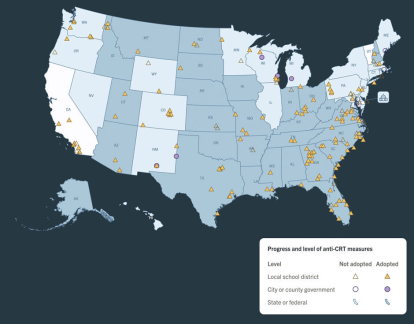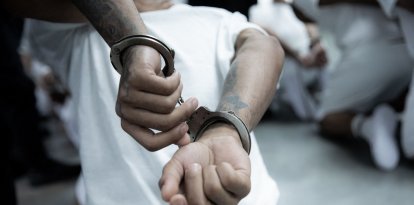The battle for education: measures against Critical Race Theory soar
A University of California database counted nearly 700 initiatives, mostly Republican-driven, since Trump left the presidency.

(Cordon Press)
There are 670 initiatives throughout the country. There are so many current initiatives to ban the teaching of Critical Race Theory (CRT). They have sprouted in little more than two years, coinciding with Biden's presidency, and not by chance. Interestingly, in this period of time, measures have been promoted in all states except the one where Democrats have won for the last 36 years. Delaware.
The information comes from a database developed by the University of California (UCLA). The CRT Forward Tracking Project compiles government proposals and regulations at the local, state and federal levels. The measures target different educational institutions: K-12, higher education, state or federal agencies, contractors and private companies or non-profit organizations.

Map prepared by CRT Forward with governmental actions to regulate the teaching of Critical Race Theory.
(CRT Forward)
Following Trump's example
During the last few months of his presidency, Donald Trump passed an executive order to "combat offensive and anti-American race and sex stereotyping and scapegoating." Biden was quick to show his disagreement: he repealed Executive Order 13950 on his first day in the oval office.
Despite Biden's haste, the data from the CRT Forward Tracking Project shows that he was late. In its short three months of life, the Republican's order was replicated in 250 measures from agencies at other levels of the government that prohibited the teaching of CRT.
The language of Executive Order 13950 "permeates all forms of anti-CRT activity," according to a project report. The most copied item in the Trumpist decree is to prohibit the teaching that "an individual, by virtue of his or her race or sex, bears responsibility for actions committed in the past by other members of the same race or sex." As of April 6, 41% of the standards included this item.
Thirty-three percent prohibited lecturing that "any individual should feel discomfort, guilt, anguish, or any other form of psychological distress on account of his or her race or sex." Twenty-one percent referred to "divisive concepts" in general.
The text enacted by Trump serves to understand what binds these sporadic efforts, spread across different agencies and governmental levels - local, state and federal - . "Many people are pushing a different vision of America that is grounded in hierarchies based on collective social and political identities rather than in the inherent and equal dignity of every person as an individual," reads the document, which also explains:
That belief of the country as fundamentally corrupt, "is now migrating from the fringes of American society and threatens to infect core institutions of our country." The order then went on to ban government personnel, uniformed services and federal contractors from promoting such discrimination. It also banned the promotion of subsidies for those purposes.
Executive Order 13950 - Com... by Santiago Adolfo Ospital
More red than blue
As expected, the states controlled by the Republican Party are the ones that pushed for the most measures. They made up 63% of the total recorded up to last month, compared to 21% of Democrat states and 16% of purple states, the ones that switched parties between the 2016 and 2020 elections.
Republicans are also more effective. According to the paper, "Blue-state law and policymakers are less effective than red and purple state law and policymakers at moving anti-“CRT” measures from introduction to adoption."
Republican Senator Bryan Hughes is the latest example. Last week, the Texas Senate passed a law that outlines that "a faculty member of an institution of higher education may not compel or attempt to compel a student enrolled in the institution to adopt a belief that any race, sex or ethnicity or social, political or religious belief is inherently superior to any other race, sex, ethnicity or belief." The second part of that text (highlighted in bold) is analogous to the first bullet point of the definition of "divisive concepts" that Trump's executive order sought to prohibit: "(1) One race or sex is inherently superior to another race or sex."
Hughes' project, which so far does not appear in the CRT Forward database, would give universities until early January to adapt to its requirements if it is ultimately approved.
K-12 children
"They train our children to be social justice warriors, to loathe our country and our history." These were the words of Xi Van Fleet, a survivor of the Chinese Cultural Revolution, to the Loudoun District School Board. "The Communist Regime used the same Critical Theory to divide people, the only difference is they used class instead of race".
This is one example of many that circulate through social media of parents, teachers and students discussing CRT in schools. And although universities are the cradle of the ideology, only 12% of anti-CRT actions are directed at them. The 90% of the measures promoted are aimed at primary and secondary education. Meaning 600 regulations. They cover both what is taught in classroom and the curricular materials used to do so.
RECOMMENDATION





















